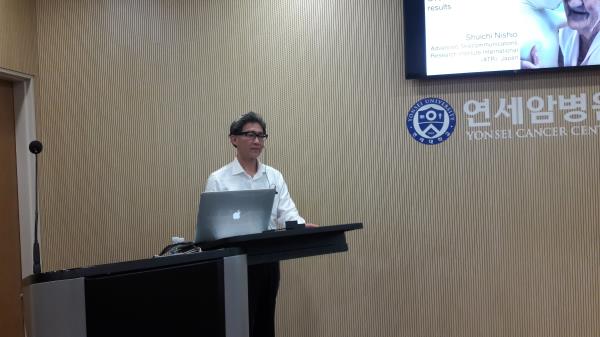To brace for a super-aged society, Korea could benchmark Japan’s active use of robots to enhance communication with dementia patients, an expert from Japan said.
Dementia patients prefer dialogues helped by robots to face-to-face talks with people and the communication with robots raises the quality of life not only for dementia patients but for guardians and caregivers who have difficulty in communicating with patients, he said.

Witnessing the effectiveness of using robots, the Japanese government partially supports robot purchase expenses through health insurance, he added.
Shuichi Nishio, a researcher at the Advanced Telecommunications Research Institute International (ATR), spoke on “'Portable android robots for aged citizens: overview and current results” at the “Dementia & Technology” conference at Yonsei Cancer Center in Seoul, Monday. The Korean Doctors’ Weekly, the sister paper of Korea Biomedical Review, organized the event.
Nishio took the example of Telenoid, which was first developed in 2010 in a combined form of telephone and robot. Now, the ART is working on Telenoids equipped with artificial intelligence (AI).
A person, who wants to talk with a dementia patient, can do so through a camera installed in the head of Telenoid. The dementia patient thinks he or she is communicating with the robot, but in reality, the patient is talking with the person. For this reason, Nishio described Telenoid as “a friendly telephone.”
To communicate with a dementia patient, it was more effective to use Telenoid than to try a direct talk, he said.
“Telenoid was developed to help dementia patients communicate with other people. Dementia patients tend to avoid engaging in conversations out of fear that other people could think that they are talking nonsense,” Nishio said. “Telenoid helps dementia patients communicate comfortably without being aware of people.”
Although Telenoid has a human face, it has an abstract body part. Such design was to help dementia patients come up with many different people through Telenoid, he added.
Nishio noted that Telenoid received the most welcome at nursing homes among shopping malls, nursing homes, and classrooms. Asked “who was better in communication, Telenoid or grandchild,” over one-third of the respondents picked Telenoid, he said.
Nishio went on to say that using Telenoid could raise the quality of life for guardians and caregivers.
“Patients with Alzheimer’s may have severe symptoms such as screaming during a conversation. Such case can be hard for the guardian or caregiver but using Telenoid could calm the patient and improve behavioral symptoms,” he said.
Nishiro emphasized that dementia patients’ preference to Telenoid to people appeared not only in Japan but in Denmark.
“We had a similar outcome in Denmark. A Danish senior had a conversation with Telenoid for over two hours,” he said. “But Danish experts raised ethical questions such as whether people should be allowed to let robots take care of their parents.”
At first, Danish caregivers worried that robots might take away their jobs but later found out that Telenoid was there to communicate only, he said, adding that both guardians and caregivers were positive about using the robot to help communication with dementia patients.
Thanks to the Telenoid’s usefulness, Japan is already supporting parts of Telenoid purchase cost through health insurance, Nishiro said.
“Telenoid is very expensive. It costs about 10 million won ($8,857), and nursing homes are using about 20 Telenoids for an experiment,” he noted. “But in Japan, health insurance covers parts of the cost. So, people can buy Telenoid in one 10th of the price.”

